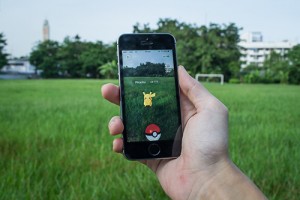 Augmented reality took a big leap forward this month with the release of Pokemon Go from Niantic Labs and partner Nintendo. This game has become very popular and has drawn praise and criticism from different groups. Many are excited about getting players young and old out of the house, but some are concerned about the potential security problems when the lines are blurred between the virtual and real worlds. Personally, I am fascinated by the social implications of this technology and its potential benefits in gaming and extended professional scenarios.
Augmented reality took a big leap forward this month with the release of Pokemon Go from Niantic Labs and partner Nintendo. This game has become very popular and has drawn praise and criticism from different groups. Many are excited about getting players young and old out of the house, but some are concerned about the potential security problems when the lines are blurred between the virtual and real worlds. Personally, I am fascinated by the social implications of this technology and its potential benefits in gaming and extended professional scenarios.
Pokemon Go
Pokemon Go requires players to chase Pokemon cartoon characters in the real world using a smart phone. It uses the smartphone camera and clock to overlay one of 151 characters in real places such as the city, the beach, the forest or in buildings. The player must collect these characters wherever they may be. Water characters can only be collected near waterways and night fairies can only be collected at night. The game has become so popular that Darwin police in Northern Australia have alerted players that they do not need to come into the police station to catch a particular character:
For those budding Pokemon Trainers out there using Pokemon Go — whilst the Darwin Police Station may feature as a Pokestop, please be advised that you don’t actually have to step inside in order to gain the pokeballs. It’s also a good idea to look up, away from your phone and both ways before crossing the street. That Sandshrew isn’t going anywhere fast. Stay safe and catch ’em all!
This is not the first augmented reality game, but so far it’s the most popular. Niantic released a similar game called Ingress in 2015. Pokemon Go uses the same database of features and is basically Ingress using Nintendo characters.
Recent History
Niantic Labs was a Google creation but spun off last fall during the Alphabet restructuring. The original intent by Google was to build things on top of the incredible mapping technology that they already have. Think about Google Maps, Google Earth, and Google Street View. They have a comprehensive database of geo coordinates, so it makes sense to augment (no pun intended) that work with a game. This is a great example of an innovation extension.
My Interest
I have seen similar application research recently in the field of education. The premise is that if young people could be enticed to go to a park or a museum or into the forest, they could learn about the features of that location and earn tokens at the same time. Basically, this is the gamification of nature or history. I have written about this topic before, but I am all in favor of enticing people to go outdoors, whether to search for cartoon characters or for solitude away from the stress and distractions of everyday life.
Thoughts
Games like Pokemon Go could be the first of many popular augmented reality games. While there are still some bugs to be worked out, the technology is promising. Have you played Pokemon Go? Do you think this is a passing fad or the beginning of a new reality? Let me know your thoughts.
Kelly Brown is an IT professional and assistant professor of practice for the UO Applied Information Management Master’s Degree Program. He writes about IT and business topics that keep him up at night.


